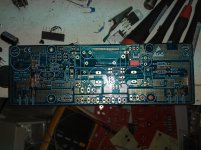Hi X,
That 'M2' cap multiplier is impressive. Could you please put up the schem again, there were a few changes...... I love Prasi's pcb too, elegant.
An IRFP240 will run with 38W and passive cooling for more than 25 years. But at 90W you'd need liquid cooling for a reasonable MTBF to avoid overheating the junctions. If you use passive cooling (my preference) you have to have either a TO264 or an ice puck device, that' HOT.
Thank you for your wonderful energy on the forum, X. You have done a huge service to the community.
HD
Here is the schematic for the layout (design by Mark Johnson, and modified by Gtose):
Here is the LTspice schematic by Gtose:
Layout by Prasi:
More in the Easy Peasy thread:
Juma's Easy-Peasy Capacitance Multiplier
Gerbers are posted in the above thread around post 512. These can be made as "add on" orders if you are already getting something at JLCPCB for $2 for qnty 10.
The cap multiplier above works phenomenally well. Just real basic parts - I am thinking of converting it to lower current (300mA) HPA duties using a smaller and less expensive TO220 BJT for the output. Just using a 10mF input smoothing cap was enough for running 1 channel for the M2 at 1.27amp bias current and about 2v drop. Note that the dropout voltage needs to be greater than the input ripple plus 1.2v in order for the cap Mx to be able to absorb the ripple. So at 2v drop I can have up to +/-400mV ripple on the input.
The cap multiplier above works phenomenally well. Just real basic parts - I am thinking of converting it to lower current (300mA) HPA duties using a smaller and less expensive TO220 BJT for the output. Just using a 10mF input smoothing cap was enough for running 1 channel for the M2 at 1.27amp bias current and about 2v drop. Note that the dropout voltage needs to be greater than the input ripple plus 1.2v in order for the cap Mx to be able to absorb the ripple. So at 2v drop I can have up to +/-400mV ripple on the input.
X, do you know if the Gtose/MJohnson CapMx has any effect on the DC offset startup issue that I had been experiencing with my ALPHA 20W? I'd like to avoid the el cheapo speaker protection relays I have been using, if possible.
X, do you know if the Gtose/MJohnson CapMx has any effect on the DC offset startup issue that I had been experiencing with my ALPHA 20W? I'd like to avoid the el cheapo speaker protection relays I have been using, if possible.
Although I have not tried it directly with the Alpha yet, the fact that the voltage rises slowly should eliminate the turn on thump. The ramp up rate can be adjusted with the RC time constant of the cap multiplier. If it is made slower than say 5 seconds, it should eliminate it.
Looking at the schematic above, it seems the time constant on this system is only 0.15sec - too fast. We would probably have to play with some simulations to slow the DC chargeup. If I look at it on an Oscope during turn on I can verify this. Probably even a DVM can see that it may be too quick in stock form.
Last edited:
Will you make another B.B.?
I don't really know. There's M2x waiting at first, then I should finally start to fix my motorbike
Although I have not tried it directly with the Alpha yet, the fact that the voltage rises slowly should eliminate the turn on thump. The ramp up rate can be adjusted with the RC time constant of the cap multiplier. If it is made slower than say 5 seconds, it should eliminate it.
Looking at the schematic above, it seems the time constant on this system is only 0.15sec - too fast. We would probably have to play with some simulations to slow the DC chargeup. If I look at it on an Oscope during turn on I can verify this. Probably even a DVM can see that it may be too quick in stock form.
I'll be watching for this and appreciate any input, sounds like a useful tweak for my upcoming alpha.
BK
I posed the question about the RC time constant in the Juma Easy Peasy CapMx thread. In the meantime, any idea which values to tweak X?
https://www.diyaudio.com/forums/attachments/power-supplies/695876d1533656392-jumas-easy-peasy-capacitance-multiplier-cap-mx-gtose-mjohnson_sch_r1-png
Hi Jwjarch,
I think it is R2/C3 and R6/C7. Currently, it is 150R/470uF combo. On the Juma Easy Peasy, this main R/C combo is 10k/220uF which has a 0.7RC time constant of 1.55 seconds. For 150R and 470uF the 0.7RC time constant is 0.05 seconds, that's 31x faster and too fast to provide a slow ramp up. I connected a DMM to the output and switched it on, and sure enough the voltage jumps up to the nominal output value almost instantaneously. This will not work for turn-on thump reduction.
If we switch the RC combo to something similar like the Juma Easy Peasy, we could simply use something like 4k7 for the R2 and R6 value. However, I am not sure how that will affect the rest of the circuit in its ability to provide the ripple reduction over the bandwidth of interest.
Let me ask Mark Johnson in other thread as he is the designer.
Good luck and happy building, Thimios! It's an easy build.
Cheers,
X
Did you sent bc557 by fault instead BC547c?
Did you sent bc557 by fault instead BC547c?
Sorry about that. You can use any small signal NPN like BC546/547/550 and it should work.
Just realized this is my 25,001 post.
Just realized this is my 25,001 post.
Wow, congrats X!
- Home
- Amplifiers
- Solid State
- Aksa Lender P-MOS Hybrid Aleph (ALPHA) Amplifier
